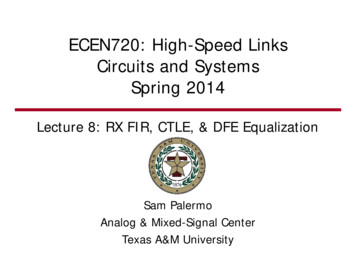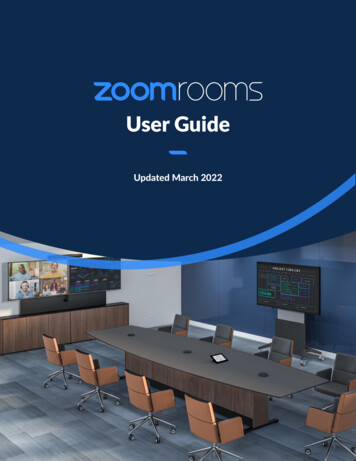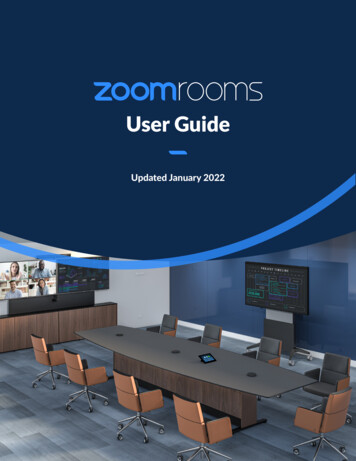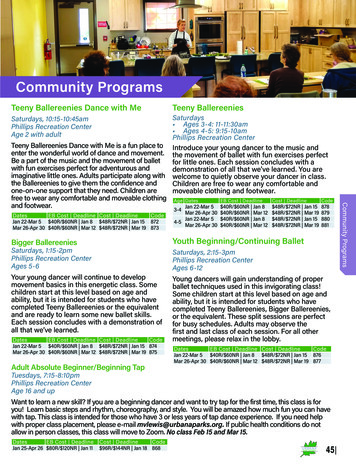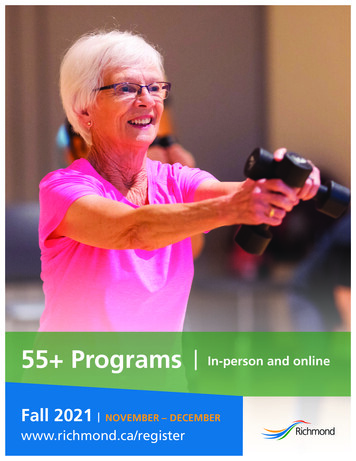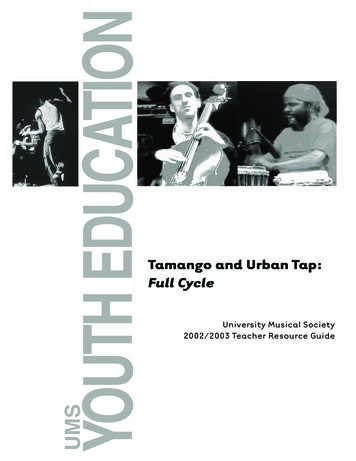
Transcription
YOUTH EDUCATIONUMSTamango and Urban Tap:Full CycleUniversity Musical Society2002/2003 Teacher Resource Guide
We would like to give special thanksto the sponsors of theUMS Youth Education Program:Ford Motor Company FundForest Health Services/Mary and Randall PittmanMichigan Council for Arts and Cultural AffairsUniversity of MichiganAssociation of Performing Arts PresentersArts Partners ProgramBank OneCafé Marie/David LoeselCommunity Foundation for Southeastern MichiganConsumers Energy FoundationDoris Duke Charitable Foundation/JazzNetFord FoundationHeartland Arts FundKeyBankMASCO CorporationTHE MOSAIC FOUNDATION (of R. and P. Heydon)National Dance Project of theNew England Foundation for the ArtsNational Endowment for the ArtsOffice of the Senior Vice Provost for Academic AffairsPepper Hamilton LLPPfizer Global Research and Development,Ann Arbor LaboratoriesProQuestTCF BankTexaco FoundationTIAA-CREFUMS Advisory CommitteeWallace-Reader’s Digest FundsAbout UMSThe goal of the University Musical Society (UMS) isto engage, educate and serve Michigan audiencesby bringing to our community an ongoing series ofworld-class artists who represent the diverse spectrumof today’s vigorous and exciting live performing artsworld.Since 1879, strong leadership coupled with a devotedcommunity have placed UMS in a league of internationally-recognized performing arts series. Today, theUMS seasonal program is a reflection of a thoughtfulrespect for this rich and varied history, balanced by acommitment to dynamic and creative visions of wherethe performing arts will take us into this new millennium. Every day UMS seeks to cultivate, nurture andstimulate public interest and participation in everyfacet of the live performing arts.UMS has expanded greatly and now presents the verybest from the full spectrum of the performing arts:internationally renowned recitalists and orchestras,dance and chamber ensembles, jazz and world musicperformers, opera and theater. Through educationalendeavors, commissioning of new works, youthprograms, artists, residencies and other collaborativeprojects, UMS has maintained its reputation for quality, artistic distinction and innovation. The UniversityMusical Society now hosts over 90 performancesand more than 150 educational events each season.UMS has flourished with the support of a generouscommunity that gathers for performances in venuesthroughout Ann Arbor, Ypsilanti, and Detroit.While proudly affiliated with the University of Michigan, housed on the Ann Arbor campus and a regularcollaborator with many University units, UMS is aseparate non-profit organization that supports itselffrom ticket sales, corporate and individual contributions, foundation and government grants and endowment income.This Teacher Resource Guide is a product of the University Musical Society’s Youth Education Program and was prepared by Kristin Fontichiaro and Susan Filipiak and edited by Kristin Fontichiaro and BenJohnson . Much of this guide is taken from press and publicity materials contributed by Tamango and Urban Tap. All photos are courtesy of the artists unless otherwise noted.
YOUTH EDUCATIONUMSTamango and Urban Tap:Full CycleYouth PerformancesThursday, Oct. 10, 11am - noonFriday, Oct. 11, 11am - noonPower Center, Ann ArborPresented with support from the Wallace-Reader’s Digest Funds. The residency activitiesassociated with this performance are presented with support from the University of Michiganas part of a special UM/UMS partnership that furthers a mutual commitment to education,creation and presentation in the performing arts.
Table of ContentsOverviewSHORT ON TIME?We’ve starred themost importantpages.ONLY HAVE 15MINUTES TOPREPARE YOURSTUDENTS?the WordTryTrySearch on p. 55.**68Coming to the ShowUrban Tap At A GlanceAbout Urban Tap**1011131416About Tamango and Urban TapAn NPR Interview with TamangoArtistic StatementWhat Will the Jam Session Be Like?The Urban Tap CompanyAbout Dance**181920212223What is Dance?Elements of DanceSome Dance VocabularyA History of Tap DanceAbout Hip HopAbout CapoeiraLesson Plans and roduction and Learner OutcomesMeeting Michigan StandardsLesson 1: Communicating with MovementLesson 2: Dance Tells StoriesLesson 3: Sharing the DanceLesson 4: Dance is Visual RhythmLesson 5: Dance ImprovisationLesson 6: Tap DanceLesson 7: Hip HopLesson 8: CapoeiraLesson 9: Elements of DanceLesson 10: Watching the VideoLesson 11: Create Your Own UMSLesson 12: Word Search and SolutionResources****4 www.ums.org58596061626364Permission Slip InformationInternet ResourcesRecommended ReadingCommunity ResourcesWorkshop for TeachersFamily PerformanceThe 2002/2003 UMS Youth Education Program
OVERVIEWRufus Cappadocia,cellist and bassist for Tamango and Urban Tap. This photo was digitally enhanced to resemble the style of imagesprojected on the screens at the rear of the stage.
Coming to the ShowWe want you to enjoy your time in the theater, so here are some tips to makeyour youth performance visit successful and fun!How do we get off the bus? You will park your car or bus in the placemarked on your teacher’s map. Only Ann Arbor Public Schools students willbe dropped off in front of the theater.Cendrillon Youth PerformanceApril 2002Who will meet us when we arrive? UMS Education staff will be outsideto meet you. They might have special directions for you, so be listening andfollow their directions. They will take you to the theater door, where usherswill meet your group. The ushers know that your group is coming, so there’sno need for you to have tickets.Who shows us where we sit? The usher will walk your group to its seats.Please take the first seat available. (When everybody’s seated, your teacherwill decide if you can rearrange yourselves.) If you need to make a trip to therestroom before the show starts, ask your teacher.How will I know that the show is starting? You will know that the showis starting because you will see the lights in the auditorium get dim, and amember of the education staff will come out on stage to say hello. He or shewill introduce the performance.What if I get lost? Please ask an usher or a UMS staff member for help. Youwill recognize these adults because they have name tag stickers or a name taghanging around their neck.Orfeo ed Euridice Youth PerformanceNovember 2001Balé Folclorico da Bahia Youth PerformanceOctober 20016 www.ums.orgWhat do I do during the show?Everyone is expected to be a good audience member. This keeps the show funfor everyone. Good audience members. Are good listeners Keep their hands and feet to themselves Do not talk or whisper during the performance Laugh at the parts that are funny Do not eat gum, candy, food or drink in the theater Stay in their seats during the performanceHow do I show that I liked what I saw and heard? In a jam session,participants and observers show their support and approval by clapping afterimpressive dance moves. At the end of the show, the Urban Tap companywill stand near the edge of the stage and bow. During the bow, the audienceclaps to acknowledge the performers. This is known as applause. Applausesays, “Thank you! You’re great!” The louder and longer the audience claps,the greater the compliment it is to the performers. If audience members reallyenjoy the performance, they may stand and clap in what is called a standingovation.
What do I do after the show ends? Please stay in your seats after theperformance ends, even if there are just a few of you in your group. Someone from UMS will come onstage and announce the names of all the schools.When you hear your school’s name called, follow your teachers out of the auditorium, out of the theater and back to your buses.How can I let the performers know what I thought? We want to knowwhat you thought of your experience at a UMS Youth Performance. After theperformance, we hope that you will be able to discuss what you saw with yourclass. What did your friends enjoy? What didn’t they like? What did theylearn from the show? Tell us about your experiences in a letter, review, drawing or other creation. We can share your feedback with artists and funderswho make these productions possible. If you had a wonderful time or if youdidn’t enjoy the experience, we want you hear your thoughts. Please sendyour opinions, letters or artwork to:Youth Education ProgramUniversity Musical Society881 N. University Ave.Ann Arbor, MI 48109-1011Fax: 734-647-1171VISIT OUR WEBSITEwww.ums.orgStudent Response toAlvin AileyYouth Performance,February 20017 Overview
Urban Tap At UrbanA GlanceTap At A GlanceTamango’sTamango is one of the world’s leading interpreters of tap dance and its connectionsto other world dance styles. His distinctive tap style features collaboration, extensiveimprovisation, a loose upper body, and rapid percussive foot sounds that The NewYorker magazine called “chatty feet.” Born in French Guiana, Tamango moved toParis at age eight and was adopted by Baron Van Cayseele, who introduced Tamangoto dance. In 1988, Tamango left Paris for New York, where he danced as a streetentertainer outside clubs and on the Staten Island Ferry. Tamango was a guest artistfor the original production of the Irish step-dancing phenomenon Riverdance and hasshared the stage with dance legends Jimmy Slyde, Gregory Hines, and Lon Cheney.He is also a visual artist, premiering his artwork in New York City in 1999.Urban Tap was created by Tamango in 1993 as a group of free-style performers who,instead of performing pre-choreographed routines, focus their attention on spontaneous improvisation and the rhythms of dance and music. Produced by Tamango,Urban Tap brings together musicians and dancers from around the world, mixingcultures and styles, predominantly tap, hip-hop, and Brazilian capoeira, all of whichoriginated in African percussive movement. By unifying world traditions onstage,Tamango hopes to bridge the gaps between world cultures. Urban Tap began in clubsbut moved to theaters beginning in 1999, winning the ensemble a BESSIE Award forexcellence in dance. Its February 2001 off-Broadway debut had a three-week sold-outrun.The Youth Performance, entitled Full Circle, brings together a jazz ensemble, worldinstruments, a Brazilian capoeira dancer (see below), hip-hop, tap, and a live videofeed from eight thumb-sized cameras placed around the stage. The entire performance is based on improvisation – unplanned, on-the-spot dances. This “jam session” format allows students a rare glimpse at the creative process.Tap dance, at its heart, consists of manipulating the feet to create sound whiledancing. The quality of sound changes depending on the part of the foot that is incontact with the floor, and the speed varies according to the speed of the steps. Tapdancers wear shoes with metal plates that create the “tap” sound. Tap dance wasa popular art form throughout the first half of the 20th century with celebrated artists including the Nicholas Brothers, Sammy Davis Jr., Bill “Bojangles” Robinson, andFred Astaire. Perhaps the best known contemporary American practitioners of tap aredancer/actors Gregory Hines and Savion Glover.Hip-hop dance is an American art form that developed primarily among AfricanAmericans as street and then club performance. Although only about 25 years old, ithas gained mainstream admiration and respect. It is an art form rooted in outstanding athleticism, precise body balance, and a seeming defiance of gravity. Hip-hoppersalmost always work in an improvisational format, with each dancer trying to “oneup” the others.Capoeira (kuh-PWEH-ruh) is a Brazilian dance style developed by slaves brought fromAfrica to the Bahian region of Brazil. Unable to practice defense techniques by theirmasters, who feared rebellion, the slaves disguised their self-defense exercises by stylizing them into dance. Today, it is respected as an important traditional art form. Itis almost exclusively performed by males, often in pairs to mimic fighting. Signaturecapoeira moves include kicking the leg over one’s head, handsprings, and mock jabs.8 www.ums.org
ABOUT URBAN TAPTamango dances on a small platform atop the stage floor. Tapping on this surface enhances the volume and quality of the soundcreated by his steps.
About Tamango and Urban TapThe New YorkerMagazine’s Profileof TamangoOnce upon a time (okay,in 1974), a nine-year-oldboy called Tamango – inhonor of the Yoruban spiritsExu and Shango – left hismother in French Guiana tolive in Paris with his father.But his father had no timefor him, and Tamango wasunhappy. Luckily, a baron,Michel Van Cayseele, livedin the same building. TheBaron helped the boy withhis Latin, and the boyhelped the Baron’s motherwith her sixteen Persiancats. Everyone was happy,and the Baron adoptedTamango, who took thename Herbin Van Cayseele.In 1988, Van Cayseeletossed a coin, and NewYork beat Rio. At first, hedanced wherever he could,busking for change outsideclubs and on the StatenIsland Ferry. Later, when hewas improvising at clubs oron tour with Savion Glover,he came into his own style:fast and chatty with hisfeet, and loose and freeabove the waist, one halfdancing to the other.Under his direction, theinternational ensembleUrban Tap, was born. “I’ma child of the world,” HerbinTamango Van Cayseele says.“It just happened that NewYork was the place whereI found something thatreminds me of home.”Excerpted from the profile byKevin Conley, The New Yorker,February 12, 200110 www.ums.orgTamango is a master of improvisation. Hailed by the New York Times as “oneof the great tap artists performing today, a dancer of astonishing speed andlightness whose feet produce a rippling, richly complex cannonade of tapbeats,” he blends the aesthetics of hip-hop culture with funk, world music,and the traditional jazz idioms of bebop and swing in a unique contemporarystyle.Born in Cayenne, French Guiana, Tamango moved to Paris at age eight andbegan a formal education in art. He started tap dancing in his early 20s at theAmerican Center in Paris and the renowned Beaux Arts de Paris, which he leftto join the university of the streets before moving to New York City.Tamango created Urban Tap in 1993, forming a group of like-minded free-styleperformers who share a unique vision and deep passion for improvisation andrhythm at the heart of dance and music. Urban Tap, produced by Tamango,is a groundbreaking fusion of world cultures bringing together dancers, musicians, and singers from around the globe. Urban Tap mixes cultures and stylesranging from Brazilian capoeira to freestyle jazz and tap – in combinationwith a hip-hop vision formed from the culture of the street. With a live videofeed rounding out the experience, it all comes together on the stage in a richproduction like no other. The work is immediate, spontaneous, and full ofhumanity, heart and soul.Urban Tap has performed in clubs throughout New York City and made itstheatrical debut at The Kitchen in 1999. This show captivated critics and thepublic and earned Tamango a New York Dance and Performance (BESSIE)Award. In February 2001 Urban Tap made its off-Broadway debut with athree-week sold-out run at The New Victory Theater.During the 2001-2002 season, Urban Tap performed extensively throughoutthe U.S. with engagements in 16 cities that consistently attracted sold-outhouses. In addition to his work with Urban Tap, Tamango has shared the stagewith dance legends Jimmy Slyde, Gregory Hines, Chuck Green, Buster Brown,and Lon Chaney, and was a guest artist in the original production of Riverdance. He has collaborated with Japanese performance artist Min Tanaka,French choreographer Philippe Decouflé, jazz bassist Christian McBride, jazzpianist Barry Harris, Brazilian percussionist Cyro Baptista and jazz drummersGrady Tate, Roy Haynes and Billy Higgins among many others.As a visual artist, he has created a significant body of work and premiered hisartwork at 17 Creations in the Chelsea district of New York City in May 1999.Urban Tap is currently developing a foundation to support its work and establish a permanent home for the company in New York City. Ultimately, theorganization intends to build an International Center for the Living Arts, whichwill develop, present, and house programs in dance, music, video, sounds, thehealing arts, and education.
An NPR Interview with TamangoThis conversation is excerpted from an interview broadcast on National PublicRadio’s Morning Edition on May 9, 2002.JON KALISH reporting: His full name is Herbin Van Cayseele Stanislaus , buthe goes by Tamango (tah-MUHN-goh), the nickname he was given as a boy inhis native French Guiana (gee-AH-nuh). As a kid, Tamango moved to Paris tolive with his dad, but he ended up being adopted by a French baron. Whenhe was 21 years old, the baron changed his life when he introduced him to anAmerican-born tap-dancing teacher.TAMANGO: After the first class, I went back home, and I was not the same.There was no doubt that I was taken by those feet, by the sound of it, by thewhole knowledge of it. Some people get hit by something and they go toanother state [of being], because the rhythm is strong and because they arevery sensitive and their body resonates. It’s a meditation when you’re so muchinto it and you transcend. And then from that you really shine and it’s notabout you anymore.VISIT OUR WEBSITEwww.ums.orgLISTEN ONLINETO THE COMPLETEINTERVIEWat data me/seg143070.htmKALISH: Tamango says that whenever he performs, he goes into a trance ofsorts. He says that he’s following in the tradition of many generations of medicine people in his family that practiced the Yoruban (yore-OOH-bin) religion. Allthe members of his ensemble, says Tamango, have a spiritual connection.TAMANGO: We are people that are in touch with spirits. The work is notwork. It’s about a prayer. It’s really about, like, sharing, and sharing, it onlyhappens when we are in a spiritual place.KALISH: Tamango says that by bringing together a myriad of styles on onestage, he’s trying to share [that] we are one people connected by the joy ofmusic and dance. Tamango has been compared to a tornado as he whirlsaround the stage bare-chested in his boa-trimmed pants. And what audiencesreally notice, beyond his vision, is what one critic described as his fast andchatty feet.JANE GOLDBERG (New York University): He just had a style of his own, youknow, right from the get-go. I mean, he’s not like anybody else, really.KALISH: Jane Goldberg is the matriarch of New York’s tap community. Shetook Tamango under her wing when he first arrived in New York in 1988. SoonGoldberg was bringing him to her classes at New York University to help teach.GOLDBERG: He’ll use a lot of space while he’s dancing. You know, he reallyjettisons across the floor and he opens up, and at the same time he still has thesound and the timing of a tap dancer.KALISH: Tamango is an improviser, which used to be rare in tap but is nowcommon. Jane Goldberg says that like other young tap dancers who performwith a world music soundtrack, Tamango is a part of the new wave of tap.11 About Urban Tap
TAMANGO: I’m not just a tap dancer, you know. I take it somewhere else,because I am from somewhere else. When you travel a lot and you’re interested in all the people’s rhythm and languages, you can only be open and justmix the whole thing and then at the end you have some kind of a sound.KALISH: Tamango’s current show is heavy on break dancing, traditional Haitian dance and moves from capoeira, the Brazilian martial art. He calls it UrbanTap. Besides being a dynamo on the dance floor, he is quite a talent scout.His current crew includes a cellist, a scat singer from India and two gravitydefying break dancers, one known as Cricket and anther who calls himself Ivan“the Urban Action Figure” Manriquez. [Editor’s note: the personnel describedhere may be different from the company performing in Ann Arbor.] There’salso a video jockey. The veejay [from “V.J.,” the abbreviation for video jockey]and his table are on stage with the musicians and dancers. He uses eight tinyvideo cameras the size of a human thumb, a video switcher and a couple ofcomputers to mix images of the live performance with canned footage of birdsflying, a tropical rain forest and a little girl dancing in the street.TAMANGO: What you see is created live. Those images, they are comingfrom some living creature, and this person is right there. The video is aboutenhancing the whole live performance. We are magicians. We createmoments on stage.Copyright 2002 National Public Radio. All rights reserved.12 www.ums.org
Artistic StatementVISIT OUR WEBSITEAs a dancer, musician and painter, Ifeel the best way to describe my workis to think of color and rhythms. Mymain focus is rhythm, not because I tapdance but because when I close my eyes inan empty room, I hear my heart beat. Andwhen I hear a sound that repeats itself, mybrain starts to vibrate miles of colors andideas, and then motion. Only when we openour eyes do we start to create from whatalready exists in the natural form.www.ums.orgI see Urban Tap as a dream that lets youthink of anything but the dance you’rewatching. Urban Tap also belongs to hiphop culture. Like tap dance, the lindy hop,break dance, and rap, it’s improvised andit’s real. My journey started a long time agobut was born out of New York City, wherepeople from across the world find refuge,express their sensitivity in what is calledart, and unleash the need for communication through the universal rhythm of dance.- Tamango Herbin Van Cayseele Stanislas13 UMS Youth Education
What Will the Jam Session Be Like?This Youth Performance may be different from other dance concerts that youhave seen. Usually, dance companies rehearse for many months, planningand practicing to make their moves perfect so that every time they perform apiece, they perform it exactly the same way.Tamango and Urban Tap are different. They still practice, but their goal isn’ta “perfect” performance that is the same each time. They are a troupe basedon improvisation. To improvise means to take your skills (in this case, in musicand dance) and make up something completely new on-the-spot, somethingthat has never been seen before. This is why we call this performance a “jamsession,” because musicians and dancers improvise and show off for eachother. Improvisation is common in the jazz world.Because Tamango and Urban Tap improvise their show, they don’t know inadvance what order the artists will appear, exactly what the music will soundlike, the combinations in which the artists will perform, or just what the danceswill look like. We know from watching their video (enclosed with this TeacherResource Guide) what their general styles and interests are, however.This is why we enjoy the following review by Vanessa Manko. It gives us asense of the atmosphere of the show, telling us about elements we might see,even though we’ll see something a bit different.The Joyce Theater in New York City is nicknamed “New York’s Home forDance” and enjoys a national reputation for presenting the finest dance companies. Many of the modern dance companies presented by UMS have performed there.The video tape that accompanies this guide was filmed duringUrban Tap’s residency at the Joyce, and their performance there was the subject of this review. Please note that the Joyce presentation featured specialguests that may not perform in Ann Arbor.Urban Tap, and More, in the House at the JoyceBy Vanessa MankoWhatever one says about Urban Tap, there is no denying the ambitious artisticvision of artistic director Tamango. Full Circle, receiving its New York premierethis week at the Joyce, is a work that not only combines tap, break, capoeira,and African dance, but also assimilates film and an abundance of musicalsounds. It is a far-reaching work and one in which the viewer will encounterthe riffs and scuffs of tap dance alongside the head-spins and other acrobatics of break dance. In addition to the melange [mixture] of dance styles, UrbanTap serves up diverse musicians and vocalists hailing from Brazil, Tunisia, Paris,Italy, Haiti, Philadelphia, and Columbia, to name a few locales. And while FullCircle is an exploration into rhythm, it is also a celebration of cultural diversity.Musicians are grouped in a semi-circle, and a large screen is set as the backdrop onto which various images are projected throughout the work. Musi14 www.ums.org
Titlecians enter one by one, each adding on a musical layer in what mounts to anall-engulfing sound. Things quiet when Tamango enters and begins his tapping.He is a fluid tap dancer, adding slides to the riffs, ball changes and lightning fastshuffles, giving his dancing an ethereal quality. What is so great about this kindof tap dancing is the complex sounds created by simple moves. What ensues isa dialogue between the dancer and the musicians; something akin to the calland recall of jazz, where dancer and musician challenge each other rhythmically.VISIT OUR WEBSITEwww.ums.orgThe hip-hop sections of this work were equally fun. The compact James P.“Cricket” Colter and Ivan Mariquez appeared to have springs in the places ofjoints as they bounced themselves, literally, off the floor and into handstands,back flips, and head spins. Sometimes it looks as if they are moving backwardand forward simultaneously, moving with a remarkable ease and control. Thisis a technique they’ve mastered and one feels confident in watching them pullout all their tricks.One of the most exhilarating performances in Full Circle is that of capoeirafree stylist Cabello of Brazil. Cabello moves with agility and grace through thesweeping kicks, handstands and continuous flow of movement of capoeira.But Cabello is as strong as he is agile. He manages to extend his body horizontally, with his entire weight resting on two arms. Another worthwhile performance was given by tap dancer Sheila Anozier. There is something aboutAnozier’s style that is hard to pin down. She has less grace as a tap dancerthan Tamango, but she offers such gumption, flare, and clear articulation thatit makes for a refreshing performance. Donning red tap shoes, she mesmerizeswith her rhythmic feats (no pun intended).On top of the wide-ranging dance and music, filmic images project on screenthroughout the work. At times these images are overpowering and too busy,with shots of cities, stills of dancers, and converging images that look like Rorschach inkblots. But what is interesting is the use of two cameras that capturethe actual dancers on stage, projecting them in what looks like daguerreotypes[Editor’s note: the earliest forms of photographs] on screen. The live dancing body is juxtaposed against the film image. It’s an intriguing effect becauseit seems to emphasize the immediacy of live performance; the film imagemoves along with the live dancer, but is caught in a sort of slow motion as if inanother dimension.The evening also featured the haunting live vocals of international pop starAmina and Vishal Vaid [Editor’s note: Amina and Vaid are not scheduled to beon the Ann Arbor tour] in addition to a plethora of musicians including DanielMoreno, Fabio Morgera, Bonga (Gaston Jean-Baptiste) and Rufus Cappadocia.In short the viewer was brought “full circle” and then some.This article originally appeared at http://www.danceinsider.com/f2002/f0322 2.html and was edited forthis guide. Copyright 2002 Vanessa Manko.15 About Urban Tap
The Urban Tap CompanyTamangoTap, didjeridoo, drumsCabelloCapoeira dancer and various BrazilianinstrumentsIvan ManriquezHip hopDaniel MorenoWorld percussionBongaHaitian percussionRufus CappadociaCello/bassFabio MorgeraTrumpetJean de BoyssonVeejay (video designer and projectionist)Carlos de MottaLive cameraThis roster is subject to change.16 www.ums.org
ABOUT DANCE
What is Dance?What is it thatmakes movementdance?For a moment, try pointing to an object in theroom as though youwere showing someonewhere it is. Now, pointagain, but this time witha difference: make themovement your arm performs more importantthat showing someonethe object. This is whatdance is about – makingmovement itself significant.How do we make movement significant? Thefirst step is to payattention to it. Most ofour everyday movementis so well mastered thatwe no longer have anyconscious awareness ofwhat we are doing; weare “on automatic.”Perform the pointingmovement again, tryingto be fully aware. Noticeif your arm moves all inone piece or if it movessequentially (first theupper arm, then lowerarm, then hand, thenfinger). Try it both waysand sense the difference. Does your arm feeltense or relaxed as it ispointing? Try doing itvery quickly and then asthough you have all thetime in the world, andnotice the difference.To dance is to discovera new world of sensoryawareness.- Sue Stinson , Dance forYoung Children: Findingthe Magic in Movement.(Reston, VA: American Alliancefor Health, Physical Education,Recreat ion, and Dance, 2001)Anyone can participate in dance. You don’t necessarily needyears of practice or special classes to enjoy it. Dance hasbeen a part of human beings’ lives since the beginning ofhistory, sometimes as a part of ceremonies or rituals, othertimes to create a performance for other people, and evenfor people to just have fun and socialize. These are a few ofthe same reasons people dance today. To explore dance is toexplore what it is to be human.Dance gives people the opportunity to express their feelings,culture and values through body movement. Every type ofdance, from break dancing to ballet, tells a story about thesociety and time in history that it comes from. However,dance is one of the few things that cultures all over the worldfrom all time periods have in common, so it is able to expressindividual cultures and the human qualities we all have i
Ann Arbor Laboratories ProQuest TCF Bank Texaco Foundation TIAA-CREF UMS Advisory Committee Wallace-Reader's Digest Funds About UMS This Teacher Resource Guide is a product of the University Musical Society's Youth Education Program and was prepared by Kristin Fontichiaro and Susan Filipiak and edited by Kristin Fontichiaro and Ben Johnson .
